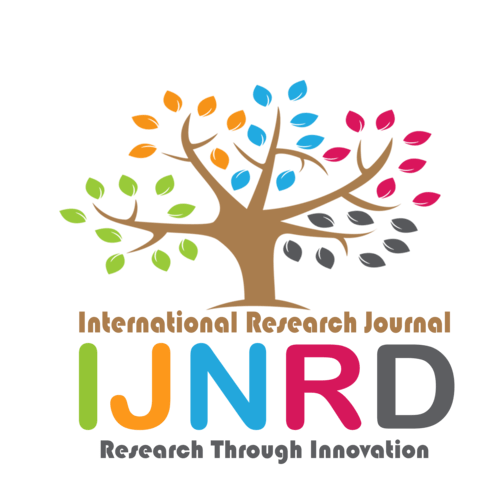|
|||||||||||||||

|
INTERNATIONAL JOURNAL OF NOVEL RESEARCH AND DEVELOPMENT International Peer Reviewed & Refereed Journals, Open Access Journal ISSN Approved Journal No: 2456-4184 | Impact factor: 8.76 | ESTD Year: 2016 Scholarly open access journals, Peer-reviewed, and Refereed Journals, Impact factor 8.76 (Calculate by google scholar and Semantic Scholar | AI-Powered Research Tool) , Multidisciplinary, Monthly, Indexing in all major database & Metadata, Citation Generator, Digital Object Identifier(DOI) |
||||||||||||||
Issue: May 2024
Volume 9 | Issue 5
Review Result and Publication of Paper within : 2-3 days
Click Here For more DetailsFor Authors
Forms / Download
Published Issue Details
Editorial Board
Other IMP Links
Facts & Figure
Impact Factor : 8.76
Issue per Year : 12
Volume Published : 9
Issue Published : 96
Article Submitted :
Article Published :
Total Authors :
Total Reviewer :
Total Countries :
Indexing Partner
Join RMS/Earn 300
Licence
This work is licensed under a Creative Commons Attribution-NonCommercial 4.0 International License







|
Published Paper Details
|
|
| Paper Title: | GRIT AND DEFIANCE OF IROM SHARMILA |
| Authors Name: | PUKHRAMBAM OLIVIA DEVI |
| Download E-Certificate: | Download |
| Author Reg. ID: |
IJNRD_213357
|
| Published Paper Id: | IJNRD2402028 |
| Published In: | Volume 9 Issue 2, February-2024 |
| DOI: | |
| Abstract: | The purpose of this study is to investigate the atrocities of AFSPA Act, 1958 and to explore the themes of resistance through Irom Sharmila, prominently known as “Iron Lady of Manipur”. The subjects of this study include the biography of Irom Sharmila written by Deepti Priya Mehrotra “Burning Bright: Irom Sharmila and the struggles for peace in Manipur” and Epic poem “Birth” written by Irom Sharmila herself. This study identifies various elements that modulate the persistent resistance pursued by Irom Sharmila. It focuses on the dimension of resistance literature that is significant in the context of North-east literature and of Irom Sharmila. The historical, socio-political and cultural contexts are used to verify this study. This study questions the power of the AFSPA and the validity of their totalitarian structure. The Act imposed to maintain law and order, rather violated all human rights and turned more tyrannical over years. We are bound to understand the nature of implementation of such an Act, which is vital in order to control the separatists’ movement; but it has failed to eliminate terrorism even after decades. “Nowhere in India does one feel more of an outsider than in the northeast – in any of the seven states. And this has nothing to do with the people or their attitude, for they are invariably friendly and hospitable“. This opening line in “Where the abnormal is Normal” written by Minnie Vaid defines the feeling of alienation faced by the north-east people from the rest of the country. Manipur, a home to over 30 distinct indigenous tribes is remotely located on the most eastern corner of India. Manipur’s existence as an independent kingdom can be traced back around two millennia according to the royal chronicle “Cheitharol Kumpaba”, following the 1891 Anglo-Manipuri war, Manipur came under British rule till 1947, and later merged with India on 1949 under the Treaty of Accession during the reign of then king Maharaja Budhachandra. This only led to popular discontent and fumed resistance movements ever since; resulting in long record of insurgency including the ethnic conflicts in the state. With the formation of United National Liberation Front (UNLF), the first separatist group active since 1964 declared their motto to form Manipur as a new country. Over time, many other groups were formed, each with different goals; such as People’s Revolutionary Party of Kangleipak (PREPAK) in 1977, People’s Liberation army (PLA) in 1978, Kangleipak Communist Party (KCP) in 1980. These groups began to rob banks, attack police officers and government buildings, demand ransom from bureaucrats. The government of India responded by promulgating the colonial Armed Forces Special Powers Ordinance on 16 April 1950 and by 1958, the Centre marked Manipur as one of the “Disturbed Area” and AFSPA (Arm Forces Special Power Act) was imposed which was a product of British Colonialism. The implementation of this “Draconian Law” is a practice of Neo-Colonialism by the Centre on Manipur, which has been burning the state since 1958 leading to unending list of cases. This Act, rather than combating the terrorism became another form of terrorism over time. Using the power as given by the Act, the army violated human rights. The Act created a culture of impunity and, in extreme cases, gave security forces the ability to commit rape, torture, carry out custodial killings, fake encounter. It proved more inhuman and beastly rather than fulfilling the responsibility of countering terrorism and protecting the lives of the citizens. With the Act granting extraordinary power to the army, they are allowed to “fire upon or otherwise use force, even leading to death of any person who is acting in contravention of any law” or against an “assembly of five or more persons”, arrest without an warrant and with the use of “necessary” force anyone who has committed or is suspected of certain offense; enter and search any premises if suspected. No trials are given to the suspected person and no legal actions can be taken up against the armed forces, the victim is the only one who loses. It led to numerous protests from different sections of the society. Women of Manipur are quick to rally and hold vigils as soon as news of atrocities reaches them; such as rape, torture, deaths, disappearances of persons, etc. One such old association is “Meira paibi”, which means ‘the torch-bearers’. Women have been in the forefront of many social movements, from the ‘Nupi-Lal’ launched in 1904 which forced the British to stop using forced labor after the Anglo-Manipuri war in 1891 when the British colonized the state. The second ‘Nupi-Lal’ in 1939 was against the policies of the Manipur Maharaja and his British agent. This fearless quality is inherited notably by the longstanding 11-year hunger strike of Irom Sharmila in opposition to the AFSPA Act. Widely known as “The Iron Lady of Manipur” and “Mengoubi” in Manipuri, meaning ‘the fair one’; she began fasting in protest on 2 November 2000, the day when ten civilians waiting at a bus-stop in Malom near Imphal were gunned down by the security forces. She was arrested 3-days after she began her fast and charged with the “attempt to commit suicide” under Section 309 of the Indian Penal Code for which the maximum sentence is imprisonment for one year, the state government extends her judicial remand year after year as she always answers in affirmative whenever the CJM asks her if she wishes to continue her fast. She was confined and imprisoned at a special ward of Jawaharlal Nehru Hospital where she is force fed through a nasal tube, administered by the Sajiva Central Jail in Imphal. She has been released for 48-hours every year for specific reasons. As Minnie Vaid in her book “IronIrom: Two Journeys: Where the abnormal is normal” questions; “Who is Irom Sharmila? Is she a human rights activist? Is she a political prisoner? Is she a prolific poet? Is she a symbol of hope for the people of Manipur?” Yes, she is all of this and much more yet she is incarcerated like a petty criminal in a small room of a hospital. Her nature of protest is completely non-violent like Mahatma Gandhi and Nelson Mandela. Irom Sharmila, by 2004 was known as an “icon of public resistance”. Many writers wrote on life and struggles based on her. To mention a few works; “IronIrom: Two Journeys: Where the abnormal is normal” by Minnie Vaid and Tayengjam Bijoykumar Singh, a mono-play titled “Le Mashale” (“Take the torch”) by Ojas S.V. I will be exploring Deepti Priya Mehrotra’s “Burning Bright: Irom Sharmila and the struggle for peace in Manipur” and the poem “Birth” written by Irom Sharmila herself. “Burning Bright: Irom Sharmila and the struggle for peace in Manipur” is an existing portrait of a heritage that has been brutally violated. It explores the struggle of people of Manipur and of Irom Sharmila, between the crossfire of militants and insurgents. It describes the lives in Manipur whose peace has been disturbed. Irom Sharmila, the ‘Iron Lady of Manipur’ stands evident to the conditions of the ravaged land of Manipur as she staked her life to bring peace to the land. Quoting Sharmila's statement which had its origins in Draupadi’s outburst in the Mahabharata, “I know you can kill me but can you save me?” It shows a plea still waiting to be heard. The problems as well as the answer remain logical but disappointedly unsolved. Therefore, what is the validity of imposing such a “Draconian Law” till date and is there an answer by the Centre for conveniently ignoring the sufferings of Irom Sharmila? The struggle of the people and state of the land has been the major context of several works written by Manipuri writers. One such work is the poem “Manipur, Why shouldn’t I love your hills?” written by Thangjam Ibopishak Singh. The vision of his poem is dark; it embodies the state brutality, ethnic conflict, the indictment of a region gripped by insurgency, the political turmoil, moral desiccation, violence and fear- as in Manipur. The poetic persona personifies Manipur from the very first line. Using different metaphors such as insects like “mosquitoes” “flies” and “leeches” to show the exploitative nature of humans. He also talks about the hypocrite leaders who promise to bring a change but they don’t. Further there are many forces that enforce violence, create disturbance over years yet there is no solution to all such practices. The persona juxtaposes the inhumane political scenarios that exist within the land of Manipur and the infinite beauty of nature that gives spiritual solace. The poem “Birth” written by Irom Sharmila herself begins with the description of the Meitei cheiraoba and further goes on giving an account of her visions. “I will write a poem, a very long poem. it will be a poem of one thousand lines. I will write about society. I will write about my experiences since my childhood. I will write about what I have seen,” Sharmila told Deepti while she was in Delhi and in solitary confinement after being arrested for a fast unto death in the year 2006. “Birth” was written in the Bengali script that she had learnt in school. Tayengjam Bijoykumar Singh later translated the poem into English. The world she envisions is a kind of utopian Manipur that is free from all the atrocities. Her lines don't reflect remotely the reason for her fast. The thirst for freedom can be far more powerful than the pangs of hunger. Abstaining from food for a great cause gives one an immense mental strength although the body gets weaker by the day. For one who has made this difficult journey the memory of the experience is etched in the mind forever, which is clearly evident in the poem. Doing a comparative study of two persons, one an indolent and the other a hard working one, Sharmila visions an ideal world by painting the real picture of the present society. Literature is the body of written works of a language, period or culture. Therefore, it has played an important role in the armed and political struggle of the people. Generally, the term "resistance" is defined as disinclination to accept, the act or an instance that tends to oppose something that the person disapproves or disagrees with. The term "resistance" was first applied in a description of Palestinian literature in 1966 by the Palestinian writer and critic Ghassan Kanafani in his study "Literature of Resistance in Occupied Palestine: 1948-1966". He wrote in his study, the literature of occupied Palestine (Israel) was, because of official repression and censorship inside Israel and studies neglect within the Arab world, largely unknown outside the borders of the 18-year-old state of Israel. According to Kanafani; "The attempts at a history of the resistance literature of a given people are usually, for reasons that are self-evident, accomplished after liberation. With respect to the literature of resistance in occupied Palestine, however, it is necessary that the Arab reader in general and the Palestinian emigrant in particular study its persistent continuation, because it is fundamentally to be found in the language itself and the speech of the Arabs of occupied Palestine. The resistance springs from these linguistic initiatives, working together with the rigidity of the conditions of the situation". In referring to Palestinian literature as "resistance literature", he is writing within a specific historical being most immediately situated within the contemporary national liberation struggles and resistance movements against Western imperialist domination of Africa, Central and South America, the Middle and Far East. Resistance Literature is engaged with an individual or an organization that struggles for national liberation in a country under military or totalitarian occupation. |
| Keywords: | AFSPA, IROM SHARMILA, INSURGENCY, MANIPUR, RESISTANCE |
| Cite Article: | "GRIT AND DEFIANCE OF IROM SHARMILA", International Journal of Novel Research and Development (www.ijnrd.org), ISSN:2456-4184, Vol.9, Issue 2, page no.a197-a215, February-2024, Available :http://www.ijnrd.org/papers/IJNRD2402028.pdf |
| Downloads: | 000118759 |
| ISSN: |
2456-4184 | IMPACT FACTOR: 8.76 Calculated By Google Scholar| ESTD YEAR: 2016 An International Scholarly Open Access Journal, Peer-Reviewed, Refereed Journal Impact Factor 8.76 Calculate by Google Scholar and Semantic Scholar | AI-Powered Research Tool, Multidisciplinary, Monthly, Multilanguage Journal Indexing in All Major Database & Metadata, Citation Generator |
| Publication Details: |
Published Paper ID:IJNRD2402028 Registration ID: 213357 Published In: Volume 9 Issue 2, February-2024 DOI (Digital Object Identifier): Page No: a197-a215 Country: Imphal, Manipur, India Research Area: Arts Publisher : IJ Publication Published Paper URL : https://www.ijnrd.org/viewpaperforall?paper=IJNRD2402028 Published Paper PDF: https://www.ijnrd.org/papers/IJNRD2402028 |
| Share Article: | |
|
Click Here to Download This Article |
|
| Article Preview | |
|
|
|
Major Indexing from www.ijnrd.org
| Semantic Scholar | Microsaoft Academic | ORCID | Zenodo |
| Google Scholar | ResearcherID Thomson Reuters | Mendeley : reference manager | Academia.edu |
| arXiv.org : cornell university library | Research Gate | CiteSeerX | PUBLON |
| DRJI | SSRN | Scribd | DocStoc |
ISSN Details
 |
 |
ISSN: 2456-4184
Impact Factor: 8.76 and ISSN APPROVED
Journal Starting Year (ESTD) : 2016
DOI (A digital object identifier)
Conference
Open Access License Policy
Important Details
Social Media
| Copyright © 2024 - All Rights Reserved - IJNRD |












Facebook Twitter Instagram LinkedIn